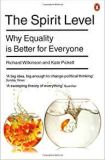Difference between revisions of "The Spirit Level: Why Equality Is Better For Everyone by Richard Wilkinson and Kate Pickett"
| Line 1: | Line 1: | ||
| − | {{ | + | {{infobox1 |
|title=The Spirit Level: Why Equality Is Better For Everyone | |title=The Spirit Level: Why Equality Is Better For Everyone | ||
|sort=Spirit Level: Why Equality Is Better For Everyone | |sort=Spirit Level: Why Equality Is Better For Everyone | ||
| Line 13: | Line 13: | ||
|date=February 2010 | |date=February 2010 | ||
|isbn=978-0141032368 | |isbn=978-0141032368 | ||
| − | | | + | |cover=0141032367 |
| − | | | + | |aznuk=0141032367 |
| + | |aznus=1608190366 | ||
}} | }} | ||
Latest revision as of 12:55, 14 April 2018
| The Spirit Level: Why Equality Is Better For Everyone by Richard Wilkinson and Kate Pickett | |
|
| |
| Category: Politics and Society | |
| Reviewer: Magda Healey | |
| Summary: A meticulously researched and richly documented argument that proves how, in developed societies, inequality is connected to numerous social ills and how greater equality has a positive effect on the whole society and not just the poorest. Important and highly recommended. | |
| Buy? Yes | Borrow? Yes |
| Pages: 368 | Date: February 2010 |
| Publisher: Penguin | |
| ISBN: 978-0141032368 | |
|
| |
If you asked people why it is (or might be) a good idea to reduce inequality in a society, many people would assume that reducing inequality works by making the life of the poorest better: that the poor are the ones who benefit from reduction of inequality.
The Spirit Level turns this notion around - perhaps not on its head, but close to it - by setting out to prove that it's the whole of society that benefits from more equality, and that these benefits apply to all, or almost all people, including those in the middle and upper income brackets.
Wilkinson and Pickett start by demonstrating that once a particular level of technological and social development is reached further increasing of the absolute wealth of the society (be it a GDP overall or total spend on health care) does not result in noticeable improvements in people's well-being. This is an important point, as it makes clear that it's only now, when the societies of the developed North-West achieved comparative affluence meaning that all basic needs of people can be fulfilled, that the goals of the development need to change. We (and twenty or so more of the richest countries) don't need more - more money, more spending, more resources, more investment. We need to ensure that all this wealth is spread more equitably throughout the society.
The core of the book analyses numerous indicators of social well being: from mental health to levels of trust, from obesity to mortality, from violent crime to drug use, many statistics are compared to show whether and how they relate to the inequality (measured by how much richer the top 20% of each society is from the bottom 20%).
Wilkinson and Pickett use two populations for their analyses: one compares the richest countries in the world, and the other compares the American states. All the relationships are, obviously, correlation: the whole argument is based on a series of regression analyses which look for a consistent relationship between two variables (inequality and whatever the indicator of well being is being looked at). Every chapter is devoted to one phenomenon and centres on two scatter graphs with a trend line super-imposed. Boring? That depends entirely on whether the reader can translate from 'dry' statistics to social meaning: the authors do their best to help, without falling into irritating anecdotes or story-telling.
One can spend a lot of time picking through the individual numbers and graphs - your reviewer certainly did - and try to come up with alternative explanations. As with any correlative study, there is nothing in the data itself that would allow us to speculate on the causal direction of the relationship: it's possible that violent crime is caused by inequality, it's also conceivable (though harder to envisage) that inequality could be a result of an inherently more violent culture, and it's also quite possible (and certainly not unlikely) that both inequality and high incidence of violent crime are caused by another factor, for example low levels of social control and conformism (I am not saying they are, or they are not, but it's an alternative explanation).
Also, and quite obviously, the countries selected for analysis differ widely in many other aspects: one of the most fascinating exercises is to look at outliers on each graph and try to understand why a particular country fails to conform to the trend. For example, the status of women in Japan (the most equal country of the analysed) and in Italy (medium equality) is lower than in many less equal societies, despite a general positive connection between equality and women's status. Similarly, the relationship between levels of mental illness and inequality is very strong, and a well fitting trend line can be drawn from Japan, Germany, Belgium and Netherlands (more equal, lower mental illness), to Australia, UK (more mental illness, less equal) to US (massive inequality, very high mental illness). But Spain and Italy have levels of mental illness as low as Japan and Germany - despite much higher inequalities. Life expectancy is correlated with equality, but some countries either buck or exceed the trend: for example Denmark has a life expectancy lower than most other countries in the analysis, despite being among the most equal, while Finns are as fat as Brits despite being much more equal.
There is also a question of measurement: many of the variables Wilkinson and Pickett analyse are not recorded in the same way - particularly factors such as mental illness and data on drug use, surveys on child happiness (in fact all surveys have a strong cultural bias in how questions are answered even if the questions asked are the same).
Many of these criticisms can be deflected by the fact that all of the relationships that were shown to be significant for countries, were also shown to exist among the US states. I would like to have seen more analyses of changes in time: ones that show how changes in equality affected other factors in the same society. There is some such data (for the UK and US) but more would help to deflect any arguments about incomparable cultures.
But in the final reading, it's the weight of the combined data that is the most persuasive. Whatever the reader's opinions on how over diagnosed mental illness might be in the Anglo-Saxon countries and for specific reasons for violence in the US, however questionable the proposed mechanisms of the correlation might be (and some of them are rather suspicious - for example the 'eating for comfort' in obesity, or taking the mental illness data at the face value), the overall message is extremely persuasive and quite clear: more equality tends to result in less social ills, and, crucially, the benefits extend to people across the income ladder, and not just the poor.
The Spirit Level doesn't argue for more government and top-down redistribution. As the authors point out, although some countries achieve higher equality by redistribution (Sweden), others start with smaller income differentials and use much less redistribution (Japan). The interesting thing is also that bigger inequalities (less redistribution) don't necessary result in lower expenditure on social services, as what is not spend on reducing inequalities ends up being spent on dealing with their results (for example crime, drug treatments, health).
The last section of the book discusses proposed solutions to the inequality, mostly via employee ownership programmes. This is fairly convincing, although rather dry and doesn't address the social and cultural aspects of inequality (class, in particular) but concentrates on income differentials. Still, it's a bold and brave proposal and one deserving of attention.
It's an important book and highly recommended.
Please share on: ![]() Facebook,
Facebook, ![]() Twitter and
Twitter and
![]() Instagram
Instagram
![]() You can read more book reviews or buy The Spirit Level: Why Equality Is Better For Everyone by Richard Wilkinson and Kate Pickett at Amazon.co.uk Amazon currently charges £2.99 for standard delivery for orders under £20, over which delivery is free.
You can read more book reviews or buy The Spirit Level: Why Equality Is Better For Everyone by Richard Wilkinson and Kate Pickett at Amazon.co.uk Amazon currently charges £2.99 for standard delivery for orders under £20, over which delivery is free.
![]() You can read more book reviews or buy The Spirit Level: Why Equality Is Better For Everyone by Richard Wilkinson and Kate Pickett at Amazon.com.
You can read more book reviews or buy The Spirit Level: Why Equality Is Better For Everyone by Richard Wilkinson and Kate Pickett at Amazon.com.
Comments
Like to comment on this review?
Just send us an email and we'll put the best up on the site.


